#Basilica di San Francesco
Explore tagged Tumblr posts
Text
Assisi: La Città della Pace e della Spiritualità. Un viaggio tra arte, fede e storia nel cuore dell’Umbria, alla scoperta della città di San Francesco e dei tesori artistici della Basilica
Assisi, situata nel cuore dell’Umbria, è senza dubbio una delle mete religiose più visitate in Italia e nel mondo.
Assisi, situata nel cuore dell’Umbria, è senza dubbio una delle mete religiose più visitate in Italia e nel mondo. Questa città non è solo un luogo di pellegrinaggio per i devoti di San Francesco, ma anche un importante centro culturale e artistico. Le sue architetture medievali, i suoi affreschi e la sua spiritualità unica creano un’atmosfera che pochi altri luoghi al mondo riescono a…
#Affreschi#Architettura Medievale#arte medievale#Assisi#Assisi patrimonio culturale.#Basilica di San Francesco#Borgo medievale#città d’arte#città della pace#cultura umbra#Dolce Vita umbra#Fede#Giotto#Giotto affreschi#luoghi da visitare in Umbria#patrimonio mondiale UNESCO#patrimonio UNESCO#Pellegrinaggio#relax in Umbria#San Francesco#Spiritualità#storia dell’Umbria#turismo artistico#Turismo Culturale#turismo religioso#Umbria#Umbria Dolce Vita#Umbria the new Dolce Vita#vacanze culturali#vacanze spirituali
0 notes
Text

Basilica of Saint Francis of Assisi through an archway
#Italy#Italia#Assisi#Umbria#Basilica of Saint Francis of Assisi#Basilica di San Francesco d'Assisi#arch#archway#travel#travel photography#church#medieval#history#religion#catholic
78 notes
·
View notes
Photo


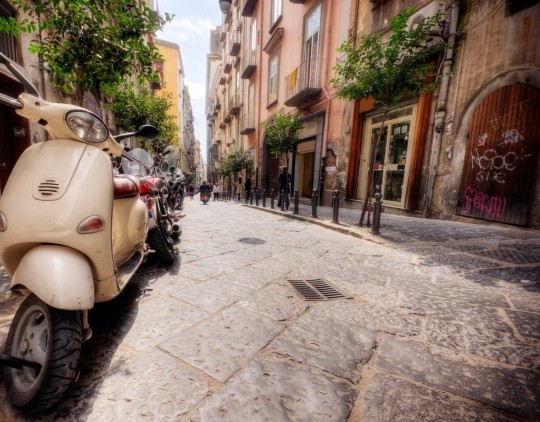
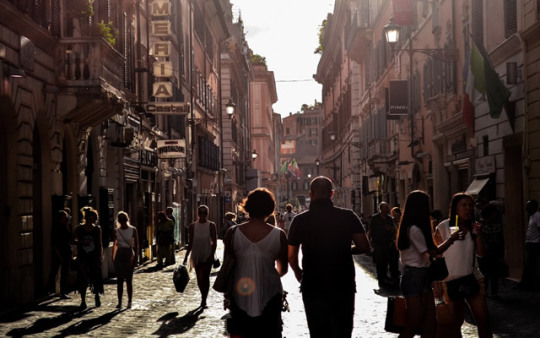
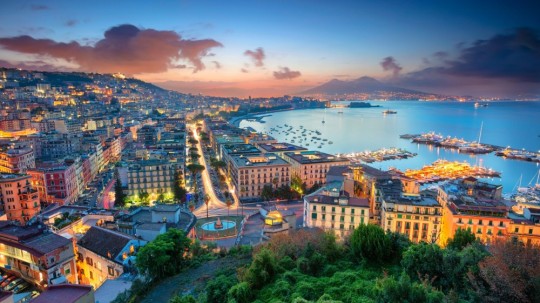
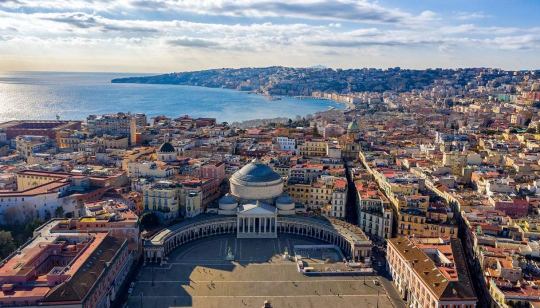
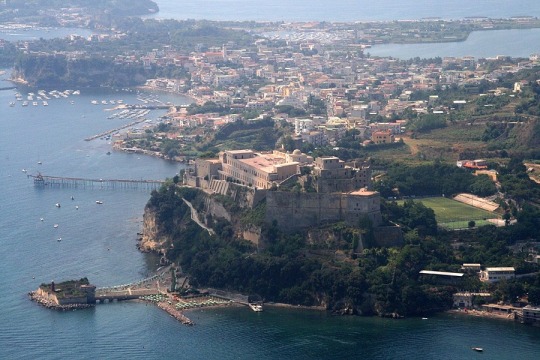



« Naples is the most mysterious city in Europe. It is the only city of the ancient world that has not perished like Iliuim, Nineveh, Babylon. It is the only city in the world that did not sink in the immense shipwreck of ancient civilization. Naples is a Pompeii that has never been buried. Naples is not a city, it is a world. It is the ancient world, pre-Christian, remained intact on the surface of the modern world. Naples is the other-Europe. »
#naples#napoli#campania#italy#south italy#mediterranean history#porto di napoli#castel sant'elmo#certosa di san martino#procida#flegrean islands#campi flegrei#castello di baia#Basilica di San Francesco di Paola#piazza del plebiscito#maschio angioino#fontana del sebeto#quotes on naples
79 notes
·
View notes
Text
Hoe je als Wolvenfluisteraar zowel Beroemd als Heilig kunt worden
Hoe San Francesco, wolvenfluisteraar van Gubbio, Toos van Holstein inspireerde tot een keramiekproject dat kunst, geschiedenis en tradities verbindt. Met heiligenverhalen en pelgrimsroutes in deze blogaflevering van TOOS&ART. #kunst #Franciscus
in het Italiaanse Gubbio De Novembermaand mag dan ook wel Slachtmaand heten, maar is Novembermaand Heiligenmaand niet veel interessanter? Ga maar na. Hebben we net Allerheiligen achter de rug, met dus ontzettend veel heiligen, komt Sint Nicolaas met stoomboot, schimmel en Sinterklaasjournaal de boel alweer op stelten zetten. Waarom dan nog niet een heilige erbij! Want ik heb iets met…
#Allerheiligen#Assisi#Basilica di Santa Maria degli Angeli#Bedevaartsroute#Beschermheilige van Italië#Chiesa di San Francesco#Devotieprentjes#Franciscus van Assisi#Franciscus van Assisi&039;s dood#Galerie Quadrige Nice#GPS#Gubbio#Heiligen in Italië#Heiligenmaand#Heiligenverering#Heiligenverhalen#Italiaanse kerken#Katholieke kunstprojecten#Katholieke mystiek#Katholieke overleveringen#Katholieke tradities#keramiek#Keramische kunst#kerkelijke kunst#La Diane Française#livre d&039;art#Middeleeuwse kerken#Nice#Pelgrimsroute Italië#Porziuncola
0 notes
Text
Alcuni elementi sono essenziali per l’autenticità del cammino spirituale. Anzitutto la crisi dell’immagine che abbiamo di noi stessi: questo è il doloroso, ma necessario inizio della conversione, il momento in cui si frantuma l’«io» non reale ma ideale che ci siamo forgiati... -Enzo Bianchi
#frati minori conventuali#frati#madonna di fatima#abramo è il nostro padre nella fede#basilica#san francesco d'assisi#europe#santità#papa francesco#rinnovamento nello spirito#spirituality
0 notes
Text

Basilica di San Francesco d'Assisi, Assisi, 2009.
30 notes
·
View notes
Text

Basilica di San Francesco d’Assisi. Assisi, Italy.
March 18, 2024
#travel#architecture#Italy#Italia#assisi#original photography#saint francis of assisi#Umbria#photographers on tumblr#lensblr#photography#urbanexploration#church#church architecture#historical architecture#wanderingjana
45 notes
·
View notes
Text
27 notes
·
View notes
Text

La storia della Musica
Ricordando Lucio Dalla ❤️
Lucio Dalla muore improvvisamente, stroncato da un infarto, il 1º marzo 2012, tre giorni prima del suo 69º compleanno, presso l'Hotel Plaza di Montreux, cittadina svizzera sede di uno dei festival musicali più importanti al mondo, il Montreux Jazz Festival, dove si era appena esibito la sera precedente. È il suo compagno Marco Alemanno a scoprire per primo il decesso, pochi minuti dopo. I primi a dare la notizia della morte del cantante sono i frati della basilica di San Francesco d'Assisi, la stessa mattina del 1º marzo, su Twitter, esattamente alle 12:10, 23 minuti prima dei lanci d'agenzia.
A due anni di distanza dalla morte del cantante, il 26 febbraio 2014, viene costituita la "Fondazione Lucio Dalla", con relativa ufficializzazione a partire dal giorno 4 marzo 2014. La fondazione avrà sede nella sua casa di via D'Azeglio a Bologna e avrà come obiettivo principale quello di valorizzare l'esperienza e il patrimonio culturale dell'artista.
Trascorsi 10 anni, la città di Sorrento gli dedica un murale.
Il 30 settembre 2022 viene pubblicato Stella di mare, singolo inedito di Cesare Cremonini e Lucio Dalla.
Ti ho guardata e per il momento
Non esistono due occhi come i tuoi
Così neri, così soli che
Se mi guardi ancora e non li muovi
Diventan belli anche i miei
E si capisce da come ridi che
Fai finta e che non capisci, non vuoi guai
Ma ti giuro che per quella bocca che
Se ti guardo diventa rossa
Morirei
Ma chissà se lo sai?
Ma chissà se lo sai?
Forse tu non lo sai
No, tu non lo sai.
Poi parliamo delle distanze, del cielo,
E di dove va a dormire la luna quando esce il sole
E di come era la terra prima che ci fosse l'amore
E sotto quale stella, tra mille anni
Se ci sarà una stella, ci si potrà abbracciare?
E poi la notte col suo silenzio regolare
Quel silenzio che a volte sembra la morte
Mi dà il coraggio di parlare
E di dirti tranquillamente,
Di dirtelo finalmente
Che ti amo
E che di amarti non smetterò mai
Così adesso lo sai
Così adesso lo sai
Così adesso lo sai
(Brano di Lucio Dalla - Chissà se lo sai)
22 notes
·
View notes
Text

"Saint Veronica of Jerusalem, Pray for Us!" #SaintoftheDay
📷 Statua di Santa Veronica di Francesco Mochi nella Basilica di San Pietro, Vaticano/#Wikipedia. #Catholic_Priest #CatholicPriestMedia
11 notes
·
View notes
Text
The House of Borgia: End of a Dynasty (Part 4)
| Part 1 | Part 2 | Part 3 | References |
While the Conclave elected Pope Pius III, Cesare was occupied trying to find allies. His old friend, King Louis XII, came to his aid, issuing a statement to Romagna that their Duke was "alive and well and the friend of the King of France". Not only Cesare had the French's support, but he also counted on Ferrara's troops to protect his claim on Romagna, as Lucrezia had persuaded her husband and father-in-law to fight in her brother's defence.
Once Romagna was relatively stable and Cesare felt better, he returned to Rome, where he met with Pius III and had his position as Captain confirmed. Not only that, but due to Cesare's clever theft of the Papal Treasury, Pius III was left financially dependent on him. By all accounts, Cesare's life would continue on exactly as it had under Rodrigo's papacy.
Unfortunately for Cesare, Pius III died twenty six days after being elected Pope. The next Pope, Julius II, had been an old enemy of Rodrigo, and upon his election, was swift to force the Borgias to surrender their lands in Romagna, even ordering the new Captain of the Papal Forces to arrest Cesare when he refused to comply.
After Cesare's arrest, Julius decided to put him on trial and encouraged those wronged by him to file claims for financial compensation. Not only that, but Julius also charged Cesare with the murder of two cardinals, whose deaths were believed to have been arranged by Rodrigo. These trials never occurred, as in April 1503, Cesare was released in exchange for his remaining territories in Romagna. Once free, he departed for Naples, which was under Spanish rule and where the rest of the Borgias had taken refuge, with the exception og Lucrezia, who remained with her husband in Ferrara. Hardly had Cesare set foot in Naples when he was imprisoned again, as King Ferdinand of Spain wished to hand Cesare back to Julius II in exchange for an alliance against the French.
Cesare would remain imprisoned in Spain until 1506, when he managed to escape prison and seek refuge with his brother-in-law, Juan d'Albret, King of Navarre. Taking advantage of a civil war wrecking through Navarre, Cesare offered his services as a military leader to help King Juan reclaim the kingdom. This would prove to be Cesare's downfall, as on 12 March 1507, he was killed in battle by the revolting troops.
Six weeks would pass until the news of his death reached Lucrazia, who was, by this point, the Duchess of Ferrara. It's said that upon learning of her brother's fate, she locked herself in her room and began to wail his name. In 1508, Lucrezia would finally give birth to a son by d'Este, named Ercole II, who would be followed by Ippolito in 1509, Leonora in 1515, Francesco in 1516 and Isabella Maria in 1519. This last birth proved itself to be terribly complicated and claimed the lives of both mother and daughter.
Rodrigo, due to being a pope, was given a tomb in the Basilica di San Pietro, near his uncle's resting place. In 1586, Rodrigo's bones were dug up and placed on a casket alongside Alfonso's, which, in 1610, was taken to Santa Maria in Monserrato degli Spagnoli, where the casket was set aside and forgotten about until 1864, when it was unexpectedly found. It would take until 1889 for the joined remains to be once again given a proper tomb, with a stone memorial being carved in honour of Alfonso and Rodrigo.
Cesare was buried in a tomb by Juan d'Albret in the church of Santa Maria of Viana, in front of the high altar. His tomb, however, was destroyed by the bishop of Calahorra some time later, with Cesare's body being dumped in a hole outside the church. In 1945, the remains were exhumed and an autopsy was performed. The remains then bounced from place to place until finally being reburied in the church in 2007.
Lucrezia, meanwhile, was buried in Monastero del Corpus Domini, in Ferrara, alongside the other Dukes and Duchess of Ferrara. In time, Alfonso d'Este joined her, as did her children and grandchildren
Thus, the era of Borgia dominance came to a close. Although the family continued to hold titles in the subsequent years (most notably, Rodrigo's great-grandson, Francis Borgia, was canonized as a saint) they never reclaimed the formidable power they once commanded during Rodrigo's papacy. Yet, Rodrigo, Cesare, and Lucrezia did not fade into obscurity. Their legacy endured, capturing the public imagination for centuries to come. Indeed, as the chronicles of their lives spread through the courts of Europe, their reputation grew, blending reality and legend. Their lives continue to fascinate audiences, inspiring countless reinterpretations in literature, drama, and visual media even to this day.
4 notes
·
View notes
Text
Quando l'asino non vuol camminare, raglia!
La disinformazione neotemplarista su San Giorgio Martire.


Care lettrici e cari lettori, come alcuni di voi sapranno, in questo lungo periodo ho ben altre cose serie a cui pensare, però sapete bene anche, quanto io mi fomenti nel momento in cui dei complottisti o negazionisti, imperversanti nel mondo "storico", si mettono ad emanar sentenze su argomenti che non dovrebbero toccare nemmeno con un bastone da rabdomante.
Questa volta tocca alla splendida chiesa di San Giorgio Martire, nel centro urbano di Petrella Tifernina in alto Molise, una cittadella che, tutta intorno, si sviluppa a guisa di quella veglia basilica, in cui, per molto tempo, ho passato periodi della mia adolescenza, quando mio padre, circa 16 anni fa, svolse numerosi sopralluoghi e studi di ricerca in compresenza del parroco Don Domenico, della sua associazione e di tanti accademici, archeologi, storici dell'arte e dell'architettura, molisani e d'oltre Regione.
Ora, come da tempo accade, è presa di mira anche da alcuni neo-templaristi, che purtroppo hanno visto troppi film d'azione sul medioevo, e soprattutto, troppi sulle leggende dei cavalieri Templari e delle crociate nella fattispecie, che vedono l'ordine come fautore di cose con le quali mai era stato legato, in tal caso, l'arrivo del culto per San Giorgio Martire nella penisola italiana, che a detta di talune pagine ed "eruditi", sarebbe sopraggiunto solo nel basso medioevo, al seguito delle crociate.
Vogliate concedermi una riflessione a riguardo, poiché affermazioni di questo tipo, ricopiate e ricalcate dalle pagine sensazionalistiche ed esoteriste, ed anche da parte di alcuni storici "non addetti ai lavori", sono assolutamente false e in evidente contrasto con la storia del nostro paese, seguendo un'ottica primitiva, oggi superata ampiamente dal mondo universitario e più propriamente storiografico.
Passerò pertanto a discutere su due punti salienti di questa lunga riflessione:
1) l'icona di San Giorgio
2) la lunetta del Magister Alferio.
Nel primo caso, viene asserita da taluni individui, la datazione della formella di San Giorgio Martire, al XIII secolo inoltrato, una cosa che assolutamente stride con qualsiasi nozione di storia dell'arte esistente, soprattutto per l'inesistente plasticità e tridimensionalità del bassorilievo, che nelle proporzioni ed irregolarità delle forme, nonché staticità dei corpi, si accosta al gran numero di produzioni di scalpellini di ambito centromeridionale tra la fine del X e la prima metà del XII secolo, con una netta evoluzione graduale tra gli stilemi arcaici preromanici di epoca longobarda/bizantina, e quelli romanici d'epoca normanna/sveva, che con la seconda fase sfocieranno nel protogotico svevo-angioino, seguendo una ripresa sempre più marcata di elementi classici, elaborazione nelle proporzioni, espressività e plasticità degli elementi, che si noterà principalmente in cantieri come quello di Santa Maria Maggiore a Monte Sant'Angelo, Santa Maria della Purificazione a Termoli, San Giovanni in Venere a Fossacesia, Santa Maria e San Leonardo a Siponto, San Clemente a Casauria e tante altre località tra Abruzzo, Lazio, Campania, Molise, Puglia ed anche Basilicata e nord della Calabria.
Per delucidazioni aggiuntive consiglio vivamente la lettura del libro: Molise medievale cristiano, Edilizia religiosa e territorio (secoli IV - XIII),di Federico Marazzi, Manuela Gianandrea, Francesco Gangemi, Daniele Ferraiuolo, Paola Quaranta, and Alessandra Tronelli.
Sulla rarità di icone preromaniche occidentali, che raffigurino il santo nell'atto di uccidere il drago, vorrei preventivamente chiarificare non sia esattamente così, la rarità è circoscritta quasi unicamente per il territorio italiano, e rarità non è sinonimo di inesistenza se il vocabolario me lo consente.
Si rammenti che nella penisola, già nel VI e nel secolo successivo si attesta la presenza del culto di San Giorgio Martire, escludendo in toto la teoria di una giunta dell'agiografia georgiana solo al seguito della sua Legenda Aurea, ma già attestata da fonti indirette ed apocrife, precedenti di molto ai secoli delle crociate, che vedrebbero la componente del mostro o drago, giungere nei territori dell'Est Europa e dell'Occidente, a cavallo tra il X e l'XI secolo, ed addirittura, essere postulata proprio in "territorio europeo" con una evoluzione graduale, che vede l'aggiunta, nella sua agiografia, del salvataggio della principessa dal drago, simbolo del demonio, una dicotomia tra bene e male che incarna tutta la storia della teologia stessa e dei santi martiri, che null'ha a che fare con le crociate, se non essere parte di esse, tanto che nel corso della prima crociata, troviamo informazioni che ci fanno capire in Occidente fosse già ben nota l'iconografia cavalleresca di Giorgio, tanto che più tardivamente, addirittura, sarebbe sviluppatasi in Oriente, adottando il mostro dall'icona di San Teodoro.
L'imago del cavaliere che sconfigge il maligno in realtà, ivi si riferiva all'imperatore Costantino, come ci riporta il biografo Eusebio da Cesarea, una icona imperiale diffusa in molte aree mediorientali, ma che principalmente era posta sulla facciata del suo palazzo imperiale, tanto da ipotizzare che in realtà i crociati furono indotti ad indentificarla come icona del santo, solo tramite una loro conoscenza di essa, già appurata e radicalizzata tra l'est Europa, l'area costantinopolitana, e naturalmente altre regioni e nazioni dell'Europa occidentale, in cui non poteva mancare certamente l'Italia, cuore pulsante delle vie pellegrinali, di commercio ed anche delle crociate stesse ed ancor prima, delle milizie d'ogni tipo, la storia della Longobardia Minor dovrebbe aver già insegnato molto.
Tornando al San Giorgio di Petrella, la sua figura trova un riscontro iconografico, molto vicino a quello delle icone ancora primitive, che precedono lo sviluppo pieno del suo programma simbologico-agiografico, fiorito in maniera solida dopo la Legenda Aurea di Jacopo da Varagine.
Che però già esisteva tra il X e l'XI secolo.In special modo, queste icone sono caratterizzate dalla assenza di elementi come la principessa, dove gli unici individui sono Giorgio, il cavallo e il drago/mostro-serpente alato, trafitto dalla lancia del soldato.
Questi elementi iconografici sono diffusissimi nelle pitture rupestri della Cappadocia (XI sec.), ed anche negli affreschi di San Marzano in provincia di Taranto (X-XI sec.), e nel bassorilievo della Cattedrale di San Paolo ad Aversa (X-XI sec.), e l'elenco di esempi su San Giorgio ed il drago possono proseguire per molto, ma mi fermerò a questi per il momento.
A fare da contorno in tutto ciò, vi è lo stile che caratterizza la scultura petrellese, una formella con caratteri iconografici bizantini, ma dalle proporzioni incoerenti e scarsa plasticità, una costante delle produzioni lapidarie che hanno toccato vari insediamenti come Santa Maria della Strada a Matrice, Ma anche altri come a Guardialfiera, Roccavivara, Guglionesi, Petacciato, Cercemaggiore e così via, tutti edifici integri alternati a resti erratici o di reimpiego, databili tra una più antica manualità dell'VIII e IX secolo, ed una lieve evoluzione tra X ed XI, con un cambiamento ulteriore nel XII ed infine un distacco abissale con le produzioni dei secoli XII-XIII e XIII-XIV, che agli antipodi posseggono la Fraterna di Isernia da un lato, e la Cattedrale di Larino dall'altro.
L'arretratezza negli attributi e nello stile figurativo, fanno retrocedere presumibilmente la datazione come di consueto, tra il termine del decimo secolo e l'anno mille, come parte di uno dei primi cantieri che videro l'evolversi dell'impianto basilicale tra stadio pre-romanico e romanico "normanno", una doppia fase che si sposerebbe bene con la successiva ulteriore trasformazione del complesso, al seguito di un cataclisma, forse uno smottamento del terreno di fondazione o un sisma, che comportò un drastico cambiamento nell'assetto impiantistico, ed un enorme riuso dei resti del precedente tempio, per approfondimenti in merito, consiglio la lettura del volume: "Medioevo in Molise: Il cantiere della chiesa di San Giorgio Martire a Petrella Tifernina" dello storico dell'arte Francesco Gandolfo, che a suo tempo avemmo il piacere di conoscere nel corso delle ricerche sul campo.
Da qui ci si sposta alla questione invece di altri elementi, come il portale maggiore, che si mostra con uno pseudoprotiro e facciata che rientra nelle caratteristiche del pre-romanico e romanico locale (vedi Matrice), con una lunetta che presenta un evidente caso di rimontaggio, come in altri punti dell'edificio, forse proprio nel corso della trasformazione dell'intero orientamento della struttura, pur presentandosi nel complesso, al suo stato originale, con stilemi a girale, fitomorfi, scene apocalittiche e creature zoomorfe inscritte dentro cornici tipiche dei cantieri, specialmente benedettini, dell'XI-XII secolo, come appunto chiarisce un ulteriore dettaglio della lunetta maggiore, la firma dell'esecutore, tal "ALFERIO DISC(IP)OLO GEO(RGI)", come si può leggere tramite una attenta analisi ravvicinata dell'incisione (e non da fotografie sbiadite, tra l'altro, che permettono egualmente di leggervi quanto detto poc'anzi).
La tradizione locale (che tradizione non è), vuole attribuire la lunetta ad un tale MAG(ISTER) EPIDIDIVS, che in realtà nasce da una approssimativa lettura dei pochi caratteri esistenti, da parte del Carandente, presa per buona da alcuni eruditi ma priva di fondamento, specie se si considera che il nome Epididio sia quasi totalmente inesistente persino per alto e basso medioevo, e per trovarvi una spiegazione, dovrebbe quantomeno essere posto in teoria come una abbreviazione, ma al momento resta una fantasiosa ricostruzione del secolo scorso, già accantonata dalla comunità accademica.
Altro strafalcione del Carandente si riporta nella data incisa al lato destro della lunetta, "MDECIM", per il quale, secondo una idea di attribuzione tarda, doveva leggersi (Anno Domini) Millesimo Duecentesimo Undicesimo (1211), non potendo però constatare per l'epoca, che nessuno dei fregi e bassorilievi della basilica, potesse essere avvicinabile a questi anni, privi di ogni caratteristica sopracitata.
Il suo errore è da contestualizzarsi nella mentalità locale di almeno uno o due secoli fa, dove il territorio molisano venne circoscritto, dal punto di vista artistico e culturale, ad una terra con "produzioni di ambito locale, o minore", con delle eccezioni senza alcun nesso, prima dei contributi che hanno permesso, da 30-40 anni, ad oggi, di sfatare tutto ciò, ed anzi, di riscoprire l'alveo culturale quale era il Molise, un territorio tra Abruzzo Citeriore, Terralaboris, Capitanata e così via, più comunemente territorio che possiamo definire proprio centro della Longobardia Minor, e successivamente, parte del Regno di Sicilia settentrionale.
Un cuore pulsante di "scuole", botteghe e cantieri ecclesiastici ed anche nobiliari, che hanno permesso l'evoluzione e il proliferare, di queste componenti artistiche, esattamente come dei movimenti, ove era cruciale il ruolo delle vie di comunicazione, per esempio la Via Francigena, le sue arterie meridionali, i tratturi e così via, che hanno permesso soprattutto, di capire negli anni passati, il motivo di una espansione di medesimi archetipi, stilemi e caratteristiche culturali riscontrabili nello stesso tempo in più parti dell'Europa, dall'Italia all'Est, al Medio-Oriente fino ad arrivare in Francia, Spagna e naturalmente Regno Unito, tante realtà che, ovviamente, si sono fuse con quanto era già presente in questi paesi.
Le componenti estere sono sempre state il fondamento base della storia dell'arte, sia in età longobarda, con influenze bizantine, occidentali ed arabe, sia con i normanni, ed ovviamente sotto Federico II di Svevia, dove si può dire fosse nata l'architettura gotica italiana (e non solo), ereditata ed espansa sotto il dominio angioino e perfezionata dai motivi orientaleggianti catalani con gli aragonesi, mentre non va trascurata la parentesi di ambito veneziano trecentesco/quattrocentesco, e anche quella del gotico abruzzese (XIII-XIV sec.).
Dopo aver riportato questo grande aneddoto sul conto del Molise, per il quale ampiamente ha dibattuto e pubblicato la professoressa Maria Stella Calò Mariani, seguita da Francesco Aceto e da Giuseppe Basile, ma anche dallo stesso Bertaux e molti prima e dopo di loro, ritorniamo alla epigrafe di Petrella.
Più semplicemente, questa attestazione in caratteri latini, di per sé in contrasto con quelli evidenziati in tutto il territorio centro-italiano del '200, (vedi la data sul campanile di Santa Maria della Strada), non si riferirebbe affatto al 1211, bensì al 1010, (AD) M(illesimo)DECIM(o), semanticamente più accurata e meno costrittoria della versione del Carandente, avvicinandosi perciò alle scene cavalleresche del campanile di Petacciato, forse ascrivibili per stile ai medesimi fregi della lunetta, che troverebbe riferimento nella vicenda della Battaglia di Canne del 1018, con la presenza forse della più antica immagine di un cavaliere normanno e di due cavalieri bizantini in lotta.
Questa lettura non solo trova riscontro nei caratteri, ma anche nello stile arcaico che compone interamente la basilica ed i suoi bassorilievi, taluni di epoca precedente, ed altri del cantiere d'appartenenza, al quale sarebbe dovuto seguire un altro cantiere come si può evincere da un unico elemento duecentesco (o trecentesco) presente nella navata destra della chiesa, un semicapitello piatto, con motivo di foglie di acanto molto plastiche ed estruse, poggiato su un’acquasantiera in disuso, mai impiegato, ma che nel suo stile sembra essere ascrivibile ai cantieri di Santa Maria e San Pardo a Larino e di Sant'Emidio ad Agnone, ma per quanto riguarda il complesso, pare in realtà esserci una totale assonanza con i cantieri delle basiliche di San Giorgio, San Bartolomeo e San Mercurio a Campobasso (IX-X-XI sec.), alcuni elementi di Sant'Andrea a Jelsi (XI sec.), San Giovanni Rotobonis a Oratino (La Rocca) (IX-X sec.), e così via.
Senza contare che, per rievocare momentaneamente le questioni del culto per San Giorgio, nella Longobardia Minor e nei territori circostanti, sono attestate molteplici ecclesie dedicate al Santo Martire, tutte tra VII-VIII e IX secolo, che farebbero già intendere quanto non sia assolutamente fondata la supposizione sul suo culto giunto solamente dopo i risvolti della prima crociata, alla fine dell'XI secolo, ricordando ulteriormente a chi legge, che stessa sorte capitò per il vescovo di Myra, Nicola, detto anche San Nicola di Bari almeno dal 1087 in poi, ma che già era ampiamente venerato dal VI secolo, persino nella nostra regione, con chiese e badie risalenti al X secolo, la più vicina alla mia posizione proprio a Petacciato, presso il luogo di sepoltura dell'abate Adamo di Tremiti, poi Sant'Adamo confessore.
La verità di tutto ciò è molto diversa, spesso dei gruppi neotemplaristi, pur di mettere i Templari al di sopra di ogni argomento storico, finiscono per affidargli la paternità di cose che non gli sono appartenute, o meglio, che non hanno creato loro ma che essi possono solo aver sposato successivamente alla loro nascita.
Quest'anno per esempio sono già dovuto intervenire dopo un convegno neotemplarista al Cinema Sant'Antonio di Termoli, in cui si sono susseguiti una marea di sproloqui nei confronti dell'Agnus Dei (Agnello di Dio, o Agnello Crucifero), presente in una moltitudine di forme nelle facciate delle nostre chiese antiche, che un "meneghino" ha definito come simbolo templare, e che queste chiese fossero state costruite perciò dai Templari, nonostante questi stesse mostrando dei fregi dell'VIII e del IX-X secolo, ed uno della prima metà dell'XI, tutti elementi che sono antecedenti sia all'ordine di San Giovanni Gerosolimitano (Ospitalieri), sia ai cavalieri Templari, con una forte affinità di carattere evangelico invece, ispirazione ancestrale di tutte le maestranze che che hanno costruito "i pilastri della terra" in cui noi veneriamo i nostri idoli.
Ecco perché non smetterò mai di ripetere una sola cosa:Studiate, studiate e STUDIATE!!!
Bibliografie di riferimento.
•San Giorgio e il Mediterraneo, in Atti del II Colloquio internazionale per il XVII Centenario (Roma, 28-30 novembre 2003), a cura di G. De' Giovanni-Centelles, Città del Vaticano, 2004.
•La Storia di Varzi, Vol. II, di Fiorenzo Debattisti, 2001.
•Jacopo da Varazze, Legenda Aurea, Einaudi, Torino 1995.
•Eduardo Ciampi, Mino Freda, Paolo Palliccia, Paolo Velonà, San Giorgio e il Drago: l'indispensabile mito. Storia, Metastoria, Arte e Letteratura, Roma, Ed. Discendo Agitur, 2023.
•Medioevo in Molise, il cantiere della Chiesa di San Giorgio Martire a Petrella Tifernina, Di Walter Angelelli, Manuela Gianandrea, Francesco Gandolfo, Francesca Pomarici, 2012.
•Bianca Maria Margarucci Italiani, San Giorgio Martire fra Oriente e Occidente, 1987.
•Pagani e Cristiani. Forme e attestazioni di religiosità del mondo antico in Emilia, XI, 2012.
•San Giorgio e il drago riflessioni lungo un percorso d'arte, Di Sebastiano Giordano, 2005.
•Il Molise medievale e moderno, storia di uno spazio regionale, Giovanni Brancaccio, 2005.
•Italian Romanesque Sculpture, An Annotated Bibliography, Di Dorothy F. Glass, 1983.
•Gycklarmotiv i romansk konst och en tolkning av portalrelieferna på Härja kyrka, Di Jan Svanberg, 1970.
•Molise, appunti per una storia dell'arte, Luisa Mortari, 1984.
•Carlo Ebanista, Alessio Monciatti, Il Molise medievale, archeologia e arte, 2010.
•Federico Marazzi, Molise medievale cristiano, edilizia religiosa e territorio (secoli IV-XIII), 2018.
•L'arte georgiana dal IX al XIV secolo, A cura di Maria Stella Calo' Mariani, Volume 1, 1986.
•L'arte del duecento in puglia di maria stella calo mariani. fotografie di paolo monti u.a, Di Maria Stella Calò Mariani, 1984
#italia#medioevo#storia#archeologia#arte#cultura#storia dell'arte#San Giorgio Martire#San Giorgio#iconografia#iconografiabizantina#iconografiacristiana#Normanni#longobardi#Arte#heritage#Molise#Petrella Tifernina#Magister Alferio
4 notes
·
View notes
Text
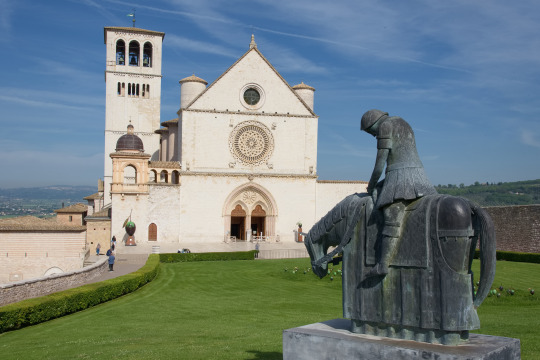
Basilica of Saint Francis of Assisi with Saint Francie on a horse sculpture
#italy#italia#assisi#umbria#Norberto Proietti#sculpture#saint francis#Basilica di San Francesco d'Assisi#horse#travel#travel photography#architecture#religion#church#history#catholicism#medieval
20 notes
·
View notes
Photo

Royal Palace of Naples, from Basilica of San Francesco di Paola, Piazza del Plebiscito. ©
#napoli#naples#royal palace of naples#campania#italy#piazza del plebiscito#Basilica di San Francesco di Paola#architecture
14 notes
·
View notes
Text
Hoe de Eugubini volledig uit hun dak gaan voor Sant'Ubaldo
Waarom worden in Italië de inwoners van Gubbio betiteld als 'de gekken van Gubbio'? Vanwege het Festa dei Ceri op 15 mei. Ik stond er middenin en doe hierbij verslag in woord en natuurlijk ook veel beeld. Een eeuwenoud feest dat niemand licht vergeet.
de drie Ceri in de basiliek Weken van tevoren, zo weet ik ervaring, merk je ‘t al in de middeleeuwse straten van Gubbio. Overal hangen de heiligenvanen uit de ramen. ‘t Gonst, ‘t ruist. Groepjes van vooral mannen zijn op z’n Italiaans opgewonden in discussie bij de diverse bars. Want het Festa dei Ceri, het Feest van de Kaarsen, zit eraan te komen op 15 mei. Maar eerst moeten op de 1e zondag…

View On WordPress
#Basilica di Sant&039;Ubaldo#ceraioli#de Heilige Franciscus#Eugubinesi#Facebook#Festa dei Ceri#Gubbio#Middeleeuwen#Museo delle "Brocche d&039;Autore"#Olympische medaille#Palazzo dei Consoli#Piazza dei Priori#Piazza Grande#Rampini Ceramiche d&039;Arte#San Francesco#San Giorgio#Sant&039;Antonio#Sant&039;Ubaldo#stadsheilige#YouTube
1 note
·
View note